Historical Notables
Black Elk
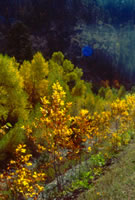 Black Elk best symbolizes the many nomadic Native American nations that inhabited the Plains and Hills. It is known that Indians were hunting buffalo on the edge of the Black Hills over 500 years ago. The Crow and Cheyenne tribes were documented living in the area more than 200 years ago. The Sioux, the best known nation, entered the area around 1780, pushing the Crow and Cheyenne south and west. The Sioux had been forced from their native home in the Minnesota region by the Chippewa, who in turn had moved into Minnesota from the East. All this was the result of pressure from the settlers moving ever westward. Black Elk best symbolizes the many nomadic Native American nations that inhabited the Plains and Hills. It is known that Indians were hunting buffalo on the edge of the Black Hills over 500 years ago. The Crow and Cheyenne tribes were documented living in the area more than 200 years ago. The Sioux, the best known nation, entered the area around 1780, pushing the Crow and Cheyenne south and west. The Sioux had been forced from their native home in the Minnesota region by the Chippewa, who in turn had moved into Minnesota from the East. All this was the result of pressure from the settlers moving ever westward.
Black Elk (1863-1950) was a holy man, priest, of the Oglala Sioux Nation who lived near Manderson, SD. He was a second cousin to Crazy Horse and knew the great chieftain well. Black Elk agreed to share his visions with a Nebraska poet, John G. Neihardt, because he wished to pass along to future generations some of the reality of Oglala life, and to share the visions that remain unfulfilled with a compatible spirit. The Great Vision and the belief of an engulfing power was 'Wasichus,' the white man's arrival. "Behold your nation, and remember what your Six Grandfathers gave you, for henceforth your people walk in difficulties."
During this time, Neihardt spent much time locked away in a cabin in Spearfish Canyon, possibly at Latchstring Inn, composing his manuscript. In 1932 the photographs and manuscripts were published in a volume called, Black Elk Speaks. With limited recorded history of the Plains Indians, this classic religious book has become a North American bible to all tribes. It is rewarding reading to guests in this inspiring natural canyon environ, especially at the 'Dances With Wolves' film site in Little Spearfish Canyon, who wish to embark on the psychic journey into the spirit and vision of Native American religion.
General Armstrong Custer
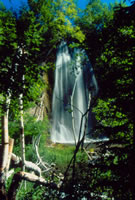 General Armstrong Custer lead an expedition to the Black Hills in 1874 to confirm the long standing rumors that there was gold 'in them thar hills.' Gold was first found along French Creek near Custer. General Armstrong Custer lead an expedition to the Black Hills in 1874 to confirm the long standing rumors that there was gold 'in them thar hills.' Gold was first found along French Creek near Custer.
Prior to that time, America's expansion bypassed the Hills 100-miles south along the California Trail in 1849 (49er's Gold rush), the Oregon Trail in the 1850's, and the Bozeman Trail to the gold fields of Montana in the 1860's. It was the discovery of gold that proved to be the key to opening the Black Hills, known as the Nation's Last Frontier, to active settlement. The word quickly spread throughout the nation. By 1875, trails from every direction were crowded, all heading for the Hills to find their fortune. An attempt was made to keep the prospectors out of the Hills according to the Fort Laramie Treaty of 1868, but was soon lost in the human flood.
The Black Hills gold rush brought hundred of miners through Spearfish Canyon in route to the gold fields of Lead and Deadwood. Many say the historic name Savoy was given by one of those miners who upon viewing the Canyon for the first time reminded him of back home in the richly forested and mineralized Savoy area of the southern Italian Alps.
Because of the rugged terrain with its dense thickets and huge boulders, the Canyon was impassable, even by horseback, for six miles between Savoy and Maurice. A visit to 11th Hour Gulch inspires a dramatic vision of what the area was like before the conquest of nature and the coming of the railroad in 1893.
Frank Lloyd Wright
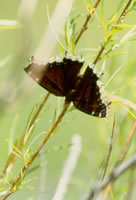 Frank Lloyd Wright, a nationally renowned organic architect, visited Spearfish Canyon in 1935. The rough, muddy and chuck-holed roadway that remained for eighteen years was the remnants of the Burlington Railroad that was pull out in 1934 after the devastating flood of 1933 near Iron Creek. Frank Lloyd Wright, a nationally renowned organic architect, visited Spearfish Canyon in 1935. The rough, muddy and chuck-holed roadway that remained for eighteen years was the remnants of the Burlington Railroad that was pull out in 1934 after the devastating flood of 1933 near Iron Creek.
Upon his return to his home in Wisconsin, he wrote an inspiring expose of his Canyon experience that was published in the Huronite Newspaper in Huron, SD.
"But how is it that I've heard so little of this miracle and we, toward the Atlantic, have heard so much of the Grand Canyon when this is even more miraculous. All the better eventually ... that the Dakota are not on the through line to the Coast ... My hat is off to South Dakota treasures."
By the early thirties, the automobile was becoming the accepted means of travel and roadways were beginning to span the Black Hills. South Dakota incorporated the roadway into the state system in the early 40's. By 1950, a new roadway, once the paths made from wildlife tracks, horse hoofs, wagon wheels, railroad spurs, and automobile tires, had been built and blacktopped and the number of vacationers steadily increased. After the flood of 1965, the State with 100% federal funding rebuilt the road from Savoy to Spearfish. In 1989, South Dakota and the Black Hills National Forest designated the roadway as a State and National Forest Scenic Byway. The roadway has provided millions of travelers with a breathtaking view ... 'always close and always upwards' ... of the Canyon's unique landscape.
Mr. Wright's observations in 1935 were fully recognized with the designation of Spearfish Canyon as a State and National Scenic Byway in 1990. For a panoramic view of the inspiring Canyon landscape, a hike on the '76 Nature Trail to Buzzard's Roost Overlook is a must.
Burlington Railroad
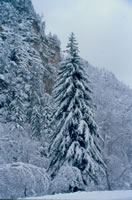 In 1893, the Grand Island & Wyoming Railroad Line opened Spearfish Canyon for the first time. The line consisted of three hundred and seventy five curves of sheer up and downhill climbing. In all, the thirty-two mile 'Spearfish Spur' left Deadwood, rose 1,886 feet in six miles to Trojan (then known as Portland), then down 2,778 feet in twenty-five miles spanning thirty-three bridges to Spearfish. In 1893, the Grand Island & Wyoming Railroad Line opened Spearfish Canyon for the first time. The line consisted of three hundred and seventy five curves of sheer up and downhill climbing. In all, the thirty-two mile 'Spearfish Spur' left Deadwood, rose 1,886 feet in six miles to Trojan (then known as Portland), then down 2,778 feet in twenty-five miles spanning thirty-three bridges to Spearfish.
Shortly after its construction, the Chicago, Burlington & Quincy Railroad bought the line for $2-Million. In an early national promoted brochure citing the engineering accomplishments, the Burlington called the Canyon trip;
"for sheer artistry of description, it need bow to no other."
The railroad was very accommodating in those days. The schedule was one train a day, and the crew was most happy to let the fisherman, sightseers, picnickers, berry pickers, and the like off any place they chose and pick then up again on the return trip.
One of the most scenic and thrilling spots on the Spearfish Canyon train ride was Spearfish Falls. The crew would stop the train on the vibrating trestle spanning the falls offering a thrilling sight of the waters thundering impact below.
With much of the timber resources depleted for railroad hauling and the automobile becoming the preferred means of transportation, the railroad was abandoned in 1933 after a devastating flood washed out two miles of track and trestles at Iron Creek. Visitors today can still live the quaint memories of this ‘era gone by’ through a walk in the Native Botanical Gardens and stopping where the trains did at the pedestrian bridge spanning Little Spearfish Creek.
Potato Creek Johnny
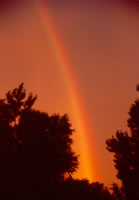 Acclaimed for finding the largest gold nugget (seven and one-half ounces) in the Black Hills, Potato Creek Johnny lived five mile west of the Latchstring Inn on Potato Creek near the Tinton gold fields. He would often visit the Inn trading his poke for vitals. Acclaimed for finding the largest gold nugget (seven and one-half ounces) in the Black Hills, Potato Creek Johnny lived five mile west of the Latchstring Inn on Potato Creek near the Tinton gold fields. He would often visit the Inn trading his poke for vitals.
Gold was discovered in the northern Black Hills during the late summer of 1875. By the following spring, bonanza strikes had been made inside Deadwood Gulch (Deadwood) and Bear Gulch (Tinton). Because these two regions became the primary focal points of the ensuing gold rush, miners quickly pioneered a trail to span the sixteen miles that lay between them. Portions of the trail, known as the '76 Trail, have been re-established for visitor to enjoy and walk in the footsteps of history. The 3/4-mile trail leads to the canyon rim at Buzzard's Roost.
George Belshaw
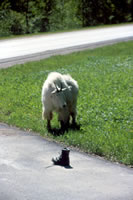 In 1891, George Belshaw built a one-room cabin at Savoy. The cabin was also used as an office by Mr. McLaughlin and Mr. Lepke who in 1892 established a sawmill across the road where the Spearfish Canyon Resort now resides. The mill, called Tie & Timber Company, employed many local ranchers and logging men for the sawing and hewing of the heavy timbers to be used in the building of the Canyon railroad which was at that time laboriously crossing the Hills from Deadwood. In the succeeding decade, much of the surrounding forest was cut to accommodate the great expansion demands made by the railroad and by ranchers, homesteaders, miners, and prospectors. In 1891, George Belshaw built a one-room cabin at Savoy. The cabin was also used as an office by Mr. McLaughlin and Mr. Lepke who in 1892 established a sawmill across the road where the Spearfish Canyon Resort now resides. The mill, called Tie & Timber Company, employed many local ranchers and logging men for the sawing and hewing of the heavy timbers to be used in the building of the Canyon railroad which was at that time laboriously crossing the Hills from Deadwood. In the succeeding decade, much of the surrounding forest was cut to accommodate the great expansion demands made by the railroad and by ranchers, homesteaders, miners, and prospectors.
In 1906, the Tie & Timber Company sold the site to Mr. Glen Inglis of Deadwood who established the first resort in Spearfish Canyon called Glendoris. During this period, Teddy Roosevelt and Seth Bullock, sheriff of Lawrence County, often visited to hunt, fish, and enjoy the beauty of Spearfish Canyon.
In 1919, new owners of the resort renamed it Latchstring Inn. Through other owners, the facilities were expanded to accommodate the growing Canyon business. In 1989, through a gift to the people of South Dakota from Homestake Mining Company, the Latchstring Inn was replaced with a modern log building. In 1995, the historic tradition of public sleeping facilities was preserved by the construction of an architecturally expressive 54-room lodge called the Spearfish Canyon Lodge.
Calamity Jane
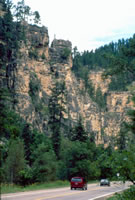 Calamity Jane is a highly recognized name in the Black Hills region from 1879 to her death in Deadwood in 1903. She was employed for a number of years with the Deadwood to Cheyenne Stage Line and as a bullwhacker from Rapid City to Ft. Pierre and from Deadwood to Cheyenne. She was best known for her relationship with Wild Bill Hickok in her Deadwood days. Calamity Jane is a highly recognized name in the Black Hills region from 1879 to her death in Deadwood in 1903. She was employed for a number of years with the Deadwood to Cheyenne Stage Line and as a bullwhacker from Rapid City to Ft. Pierre and from Deadwood to Cheyenne. She was best known for her relationship with Wild Bill Hickok in her Deadwood days.
The Deadwood to Cheyenne stagecoach would make scheduled stops at Spearfish Crossing, now known as Cheyenne Crossing, at the south end of Spearfish Canyon. While employed as a shotgun-rider, folklore has it that she killed four stage robbers and notched her Winchester rifle stock to mark the number of her victims.
In 1905, Glen Inglis, then owner of Glendoris, later named Latchstring Inn, reportedly bought the rifle at an auction in Deadwood. The rifle with four notches on its stock remains in the Latchstring Collection on display by the Spearfish Canyon Foundation.
Life was hard and basic in the region during her era. In the Canyon, the drivers would 'roughlock' the wheels of their wagons with logs or chains to prevent them from turning, hitch the horses to the rear, and slowly skid down the slope. Breakneck Gulch near here was named after a rough-locking accident that occurred nearly one hundred years ago.
President Theodore Roosevelt
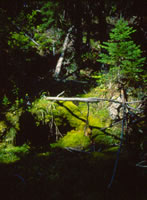 Teddy Roosevelt, 26th President of the United States, began to make his mark in the history of Spearfish Canyon in the 1880's in numerous hunting expeditions to the Dakota Territory. Many times he and his friend Seth Bullock, Sheriff of Deadwood, would hunt deer, bear, and mountain lion in the rugged Canyon landscape. Teddy Roosevelt, 26th President of the United States, began to make his mark in the history of Spearfish Canyon in the 1880's in numerous hunting expeditions to the Dakota Territory. Many times he and his friend Seth Bullock, Sheriff of Deadwood, would hunt deer, bear, and mountain lion in the rugged Canyon landscape.
In 1893, President Grover Cleveland nominated the Black Hills and twelve other American forests as national forest reserves. Geological surveys were first required before the reserves would be officially designated. The Latchstring Collection of the Spearfish Canyon Foundation contains the first geological survey of the Canyon printed in 1899. Later, in 1901, under then Vice-President Roosevelt authority, Bullock was appointed as the first Black Hills forest supervisor. In 1905, congress, at the urging of President Roosevelt, created America's National Forest system.
Upon Roosevelt's death in January of 1919, Sheep Mountain near Deadwood was dedicated Mt. Theodore Roosevelt. Efforts were made to dedicate parts of Spearfish Canyon as the "Theodore Roosevelt Bird and Wildlife Sanctuary," but before the work was finished, the sponsor, Seth Bullock, died. You will enjoy the natural bird sanctuary within the old forest along the Spearfish Canyon Floor Trail.
John Muir
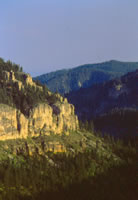 John Muir, America's most famous and influential naturalist and conservationist, served as an unofficial advisor to a National Forestry Commission that approved the first timber sale on America's public forest lands in 1899 near Nemo in the Black Hills of South Dakota. As a wilderness explorer, he is renowned for his lone excursions in California's Sierra Nevada and redwood forests, among Alaska's glaciers, and worldwide travels in search of nature's beauty. John Muir, America's most famous and influential naturalist and conservationist, served as an unofficial advisor to a National Forestry Commission that approved the first timber sale on America's public forest lands in 1899 near Nemo in the Black Hills of South Dakota. As a wilderness explorer, he is renowned for his lone excursions in California's Sierra Nevada and redwood forests, among Alaska's glaciers, and worldwide travels in search of nature's beauty.
The Forestry Commission surveyed parts of the country to see if there were public forestlands that should be saved from'‘excessive use' of lumber, sheep, cattle, and mining industries. Muir accompanied these officials on their trip to the Black Hills. They found the Black Hills in South Dakota being ruined, and the Big Horns of Wyoming reduced to forest stumps. Similar conditions were found in Idaho, Montana, Oregon, Washington, and California. Muir did not oppose timber harvest under proper regulations.
In 1901, Muir published Our National Parks, the book that brought him to the attention of President Theodore Roosevelt. In 1903, Roosevelt visited Muir in Yosemite. There, together, beneath the trees, it is reported they laid the foundation of Roosevelt's innovative and notable conservation programs including the Black Hills National Forest. You too can enjoy togetherness beneath the trees on a restful one-mile walk up Roughlock Trail to the falls.
Hugh Glass
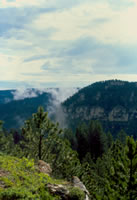 Hugh Glass, a notable Black Hills and South Dakota mountain man and trapper of the very early 1800's, represents the first arrival of the white man into the Black Hills. Parties of fur traders went into the western wilderness before Lewis and Clark finished making reports on their 1804-1806 expedition. For approximately forty years, trappers searched for beaver up almost every stream in the West, no doubt including Spearfish Creek where beaver were abundant at that time. Hugh Glass, a notable Black Hills and South Dakota mountain man and trapper of the very early 1800's, represents the first arrival of the white man into the Black Hills. Parties of fur traders went into the western wilderness before Lewis and Clark finished making reports on their 1804-1806 expedition. For approximately forty years, trappers searched for beaver up almost every stream in the West, no doubt including Spearfish Creek where beaver were abundant at that time.
Folklore has it that Hugh Glass may have unwillingly served under pirate Jean Lafitte, and upon escaping, lived with the Pawnees for a while. In 1823, he joined one hundred mountain men of the Rocky Mountain Fur Company in the second expedition up the Missouri. On the expedition, he was badly mauled by a grizzly bear and left for dead. His quest to survive -- crawling through the Badlands, eating insects, the ebb and flow of the relationship between man and nature and between the individual and the group -- has become a legend of the mountain men who forged a pathway to civilization in the Black Hills. The account of his survival is published in the book called Lord Grizzly. To achieve a sense of the remote uncivilized forest in which the mountain man existed, take a hike up Breakneck Gulch to the rim at Needle's Eye overlooking the Lodge ... you'd be wise to take a compass and map! |


